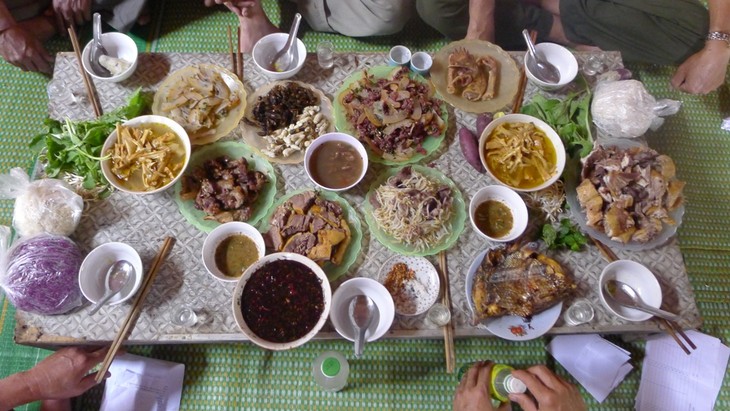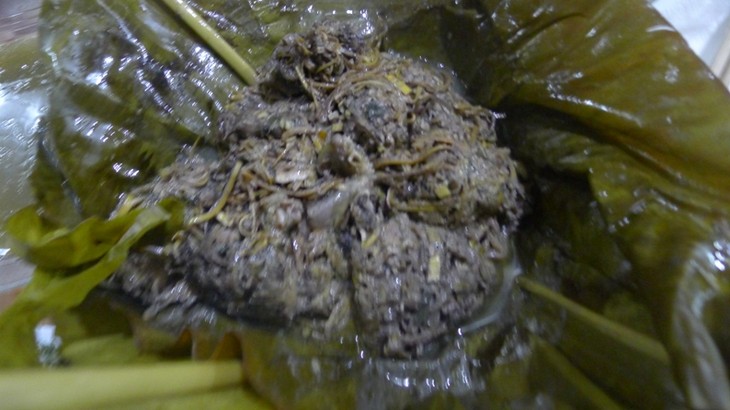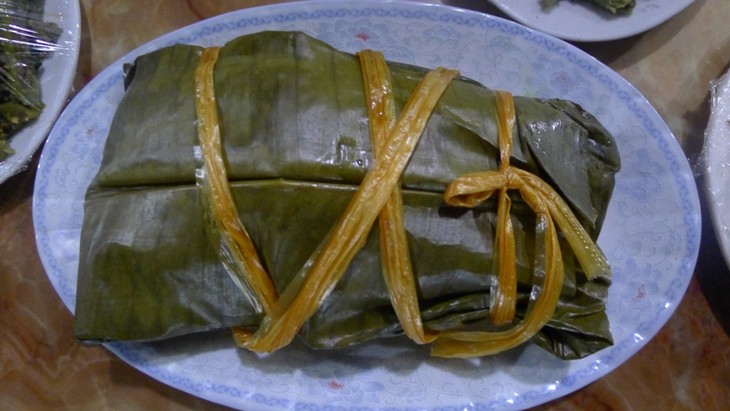(VOVworld) – Visitors to Dien Bien are impressed by the province’s efforts to preserve ethnic cultural values, including costumes, housing, daily activities and rituals. Their traditional distinctive cuisine also makes the Thai ethnic culture special.
 |
| A tray of food of the Thai people (Photo: Lan Anh) |
On a working trip to Muong Lay, where the Thai people live, we were treated to a traditional Thai meal at Hoang Thi Hang’s house in Lay Nua commune. We admired Hang’s cooking skills as she prepared a dozen dishes beautifully arranged on a tray. Hang said that traditional spices and herbs play an important role in Thai gastronomy: “The ingredients are seasonal and the way of cooking is important. It takes us a lot of energy and effort to make a good dish”.
Hang said the most typical food of the Thai is grilled food because of its spices and nutrition. Pork, beef, poultry and seafood can be grilled. But the most impressive is grilled stream algae. Algae have the best taste in late autumn because the stream water flows rapidly, making the algae green and soft as velvet. After being cleaned, the algae is mixed with a special kind of seed called dổi, chili peppers, garlic, ginger, lemon grass, lemon leaves and fat. The mixture is wrapped in arrowroot leaves and tied with bamboo strings. The wraps are hung on a bamboo shelve and then burried in hot ashes. The final product temps you with the smell of arrowroot leaves mingled with all the other ingredients. Putting a bite of cooked algae in your mouth and sipping some rice wine produces a pleasant taste that lingers.
On Hang’s food tray are are three dishes wrapped in arrowroot and banana leaves, typical of Thai cuisine. Khoang Van Tien, a resident of Lay Nua commune, says that because the Thai used to live in mountainous areas with limited cooking tools, they learned to use leaves for cooking. Although their lives have changed, the Thai still maintain their traditional cooking methods:“Thai food is diverse and stems from poverty. Today, returning from the farm, I picked some leaves for our meals. I tried to catch some fish but failed, so I picked some algae to cook”.
 |
| Duck simmered with banana inflorescense (Photo: Lan Anh) |
Hang showed us a dish made from duck that looked strange and was an ugly color. But the taste was distinctive: sweet, pungent and greasy: “This dish is called duck simmered with banana inflorescense. It was simmered for some 3 hours over a small fire. The duck is marinated with many ingredients such as chili, ginger, lemon grass, and chicken powder”.
 |
| Minced pork wrapped in banana leaves (Photo: Lan Anh) |
The minced pork mixed with other ingredients and wrapped in banana leaves is really delicious. Pork, a staple dish of the Vietnamese people, has become a specialty thanks to the skillful hands of the Thai women. The meat mixture after being steamed for more than 1 hour becomes soft, sticky and fragrant.
 |
| Khảu Sén fried cake (Photo: Lan Anh) |
The Thai people are also proud of their fried cake called Khảu Sén. The thin, yellowish cake is rather crispy. Hang says this traditional cake requires thorough preprations: “Traditionally, we make the cake once a year during the Lunar Year Festival. The main ingredient is young casava powder. The casava is scraped, ground, kneaded and dried. We can cut the material in whatever shape we like”.
Steamed sticky rice is a staple of the Thai peple. Cooked in an wooden steamer, the rice is soft and glutinous but does not stick to eaters’ fingers. It is stored in a closed small bamboo basket. On special occassions, the Thai mix the rice with a variety of leaves to produce natural colours such as purple and yellow.